10 Brand Strategy Metrics CMOs Should Track
Tracking the right metrics can make or break your brand strategy. Companies using six or more metrics grow 2.3x faster than competitors. Here’s a summary of the 10 most important metrics CMOs should focus on:
- Brand Health : Monitor your target market’s awareness (unaided and aided), familiarity, consideration, and first choice metrics for your brand.
- Share of Voice (SOV) : Measure your visibility across social, search, paid, and earned media. Benchmark against competitors.
- Net Promoter Score (NPS) : Gauge customer loyalty. Scores above 30 are strong; 70+ is exceptional.
- Customer Acquisition Cost (CAC) : Track how much it costs to gain new customers. Keep a healthy CLV:CAC ratio of 3:1.
- Customer Lifetime Value (CLV) : Calculate the total revenue a customer brings over time. Focus on increasing retention and upselling.
- Website Conversion Rates : Optimize your site to turn visitors into customers. Industry benchmarks range from 2% (B2B) to 11% (media).
- Social Media Performance : Track engagement rates, sentiment, and how social drives traffic to your site.
- Marketing ROI : Measure the return on your marketing investments. Aim for 250-400% ROI depending on your industry.
- Lead Conversion Success : Analyze how well you convert leads into paying customers. Focus on visitor-to-lead and lead-to-close rates.
- Brand Value: Assess your market share, price premium, and customer retention to understand long-term brand equity.
Quick Overview of Metrics
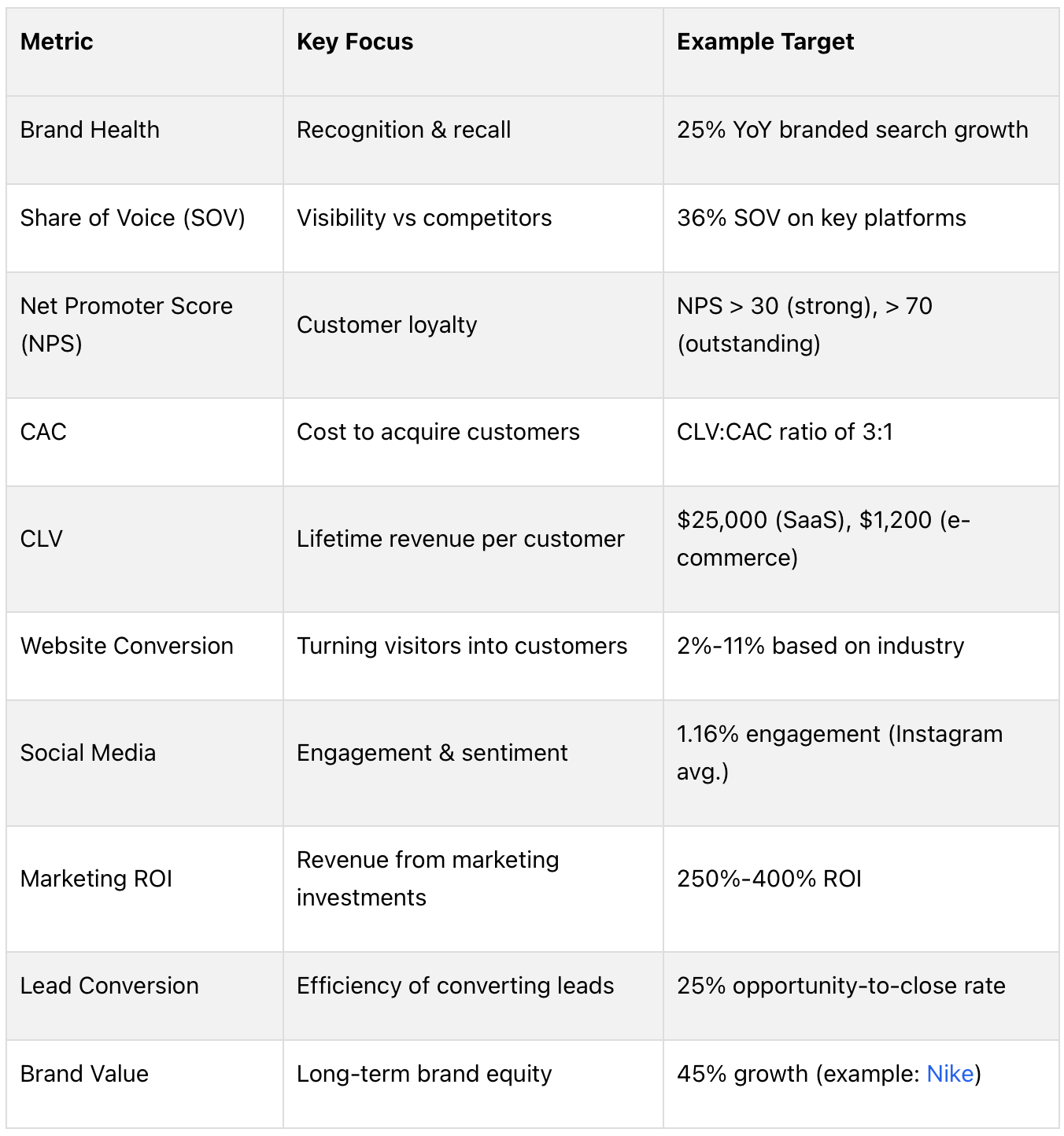
These metrics work together to track brand health, improve decision-making, and link marketing efforts directly to business growth. Start by prioritizing metrics that align with your current business phase - whether it’s building awareness, driving conversions, or maximizing lifetime value.
What are the most important branding KPIs
1. Brand Health Measurement
Brand health uses consumer insights to give a complete picture of your target’s awareness for you brand. As the starting point for evaluating performance, brand awareness focuses on two key aspects: aided (how well your brand is visually identified) and unaided (how easily people remember your brand without prompts).
Here are the three main areas to track:
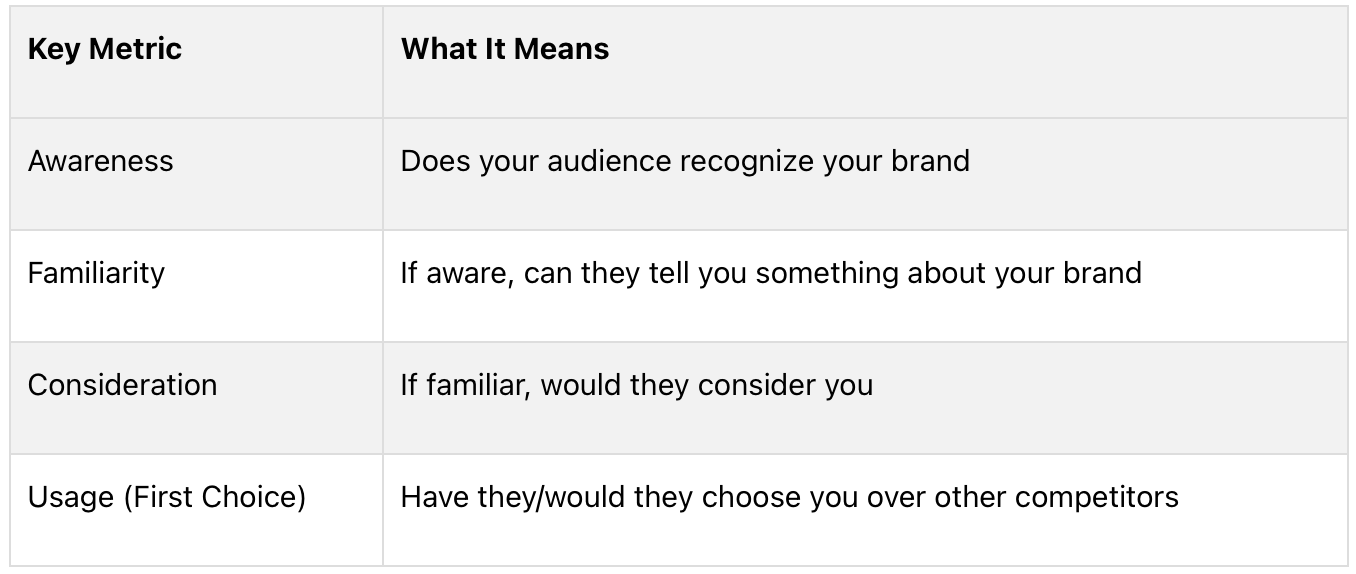
Brands that excel in awareness use a mix of these methods. For instance, Coca-Cola achieves a 94% aided recognition rate but only 65% unaided recall in the beverage market [5][7]. This highlights the importance of tracking both recognition and recall.
To put this into action, CMOs can focus on:
- Analyzing the digital footprint with tools like Semrush
- Conducting quarterly surveys
- Monitoring branded search growth, aiming for a 25%+ year-over-year increase [3]
For benchmarks, B2C brands should aim for 10,000+ monthly social mentions, while B2B brands typically target around 2,000+. Recognition goals also differ: B2C brands often target 15-25% unaided recall, while B2B brands aim for 8-12%.
Understanding these metrics sets the stage for the next key performance indicator: Share of Voice Analysis, which measures how visible your brand is compared to competitors.
2. Share of Voice Analysis
Share of Voice (SOV) measures how much visibility your brand has across various channels, helping you decide where to focus resources and how to position against competitors. Using insights from brand awareness tracking, modern SOV analysis focuses on four main channels:
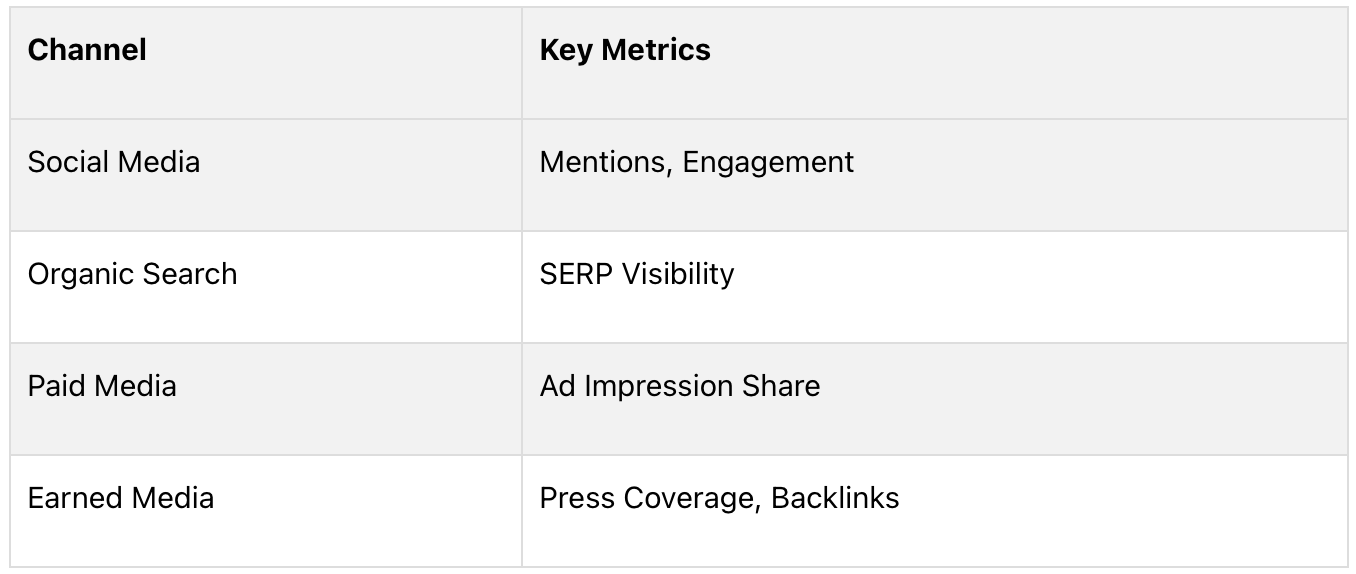
Take the fast-food industry as an example: In 2024, McDonald's held a 36% SOV on Twitter, outpacing Wendy's (19%) and Burger King (15%) [1]. This level of visibility shaped their market position and boosted customer engagement.
To track SOV effectively, CMOs should focus on these key areas:
Cross-Channel Monitoring
Keeping tabs on social media and news platforms in real time allows not only for tracking mentions but also for analyzing their tone. This ensures you understand both the quantity and quality of your brand's visibility [1][3].
Competitive Benchmarking
Context is everything. A 10% SOV might be a win in a niche B2B market but could signal underperformance in broader consumer sectors [8]. Regularly comparing your performance to competitors helps define realistic goals for your industry.
Strategic Response
If your SOV changes, acting fast is critical. For instance, a beverage company successfully regained visibility by shifting 20% of its budget to TikTok creators, achieving a 20% share within three months [3]. This shows how reallocating resources can align with business goals and quickly address gaps.
To get the most out of SOV tracking, combine it with sentiment analysis. High visibility doesn’t always mean positive results. Real-time data lets you adapt your strategy quickly when market conditions change [1][3].
This visibility also influences customer perceptions, often reflected in metrics like Net Promoter Score (NPS).
Net Promoter Score Tracking
Net Promoter Score (NPS) is a simple yet powerful way for CMOs to gauge customer loyalty and predict how well a brand might grow. Building on insights from Share of Voice analysis, NPS helps turn visibility into measurable customer advocacy.
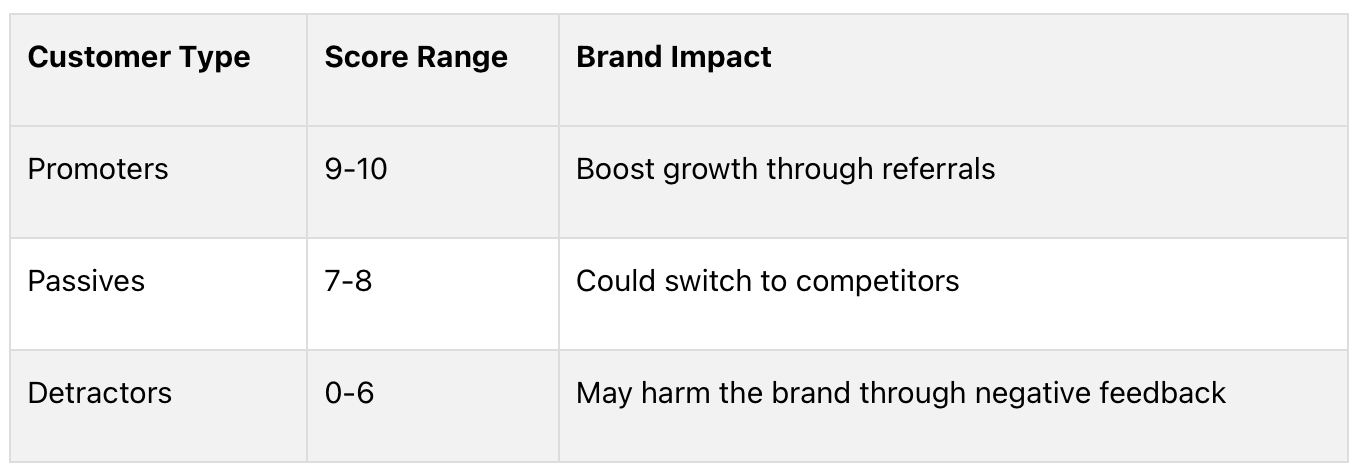
The formula is easy: subtract the percentage of Detractors from Promoters. For example, if 50% of customers are Promoters and 20% are Detractors, the NPS is 30 [1]. While industry benchmarks vary, a score above 30 reflects strong brand health, and anything over 70 is considered outstanding [1][2].
Practical Examples
Apple's NPS of 72 (2023) [2] and Slack’s 25% reduction in churn [2][4] highlight how leveraging NPS can lead to real business gains.
Key Ways to Track NPS:
- Post-purchase surveys: Placed in transaction confirmations to get instant feedback.
- Quarterly campaigns: Use survey platforms to track trends over time.
- Social listening tools: Capture unprompted customer sentiment online [1][5].
Tying NPS to Business Growth
Brands with high NPS grow twice as fast as their competitors [2]. Plus, Promoters tend to spend 20% more annually compared to Detractors [2].
How to Act on NPS
To get the most out of NPS, focus on:
Improving loyalty not only drives higher spending but also reduces Customer Acquisition Costs, boosting overall efficiency.
4. Customer Acquisition Costs
NPS measures loyalty's role in growth, but CAC tells you how much that growth costs. As your brand gains traction, CAC should drop due to more organic customer acquisition - making it a critical metric for evaluating your marketing strategy. To calculate CAC, divide your total marketing spend by the number of new customers gained.
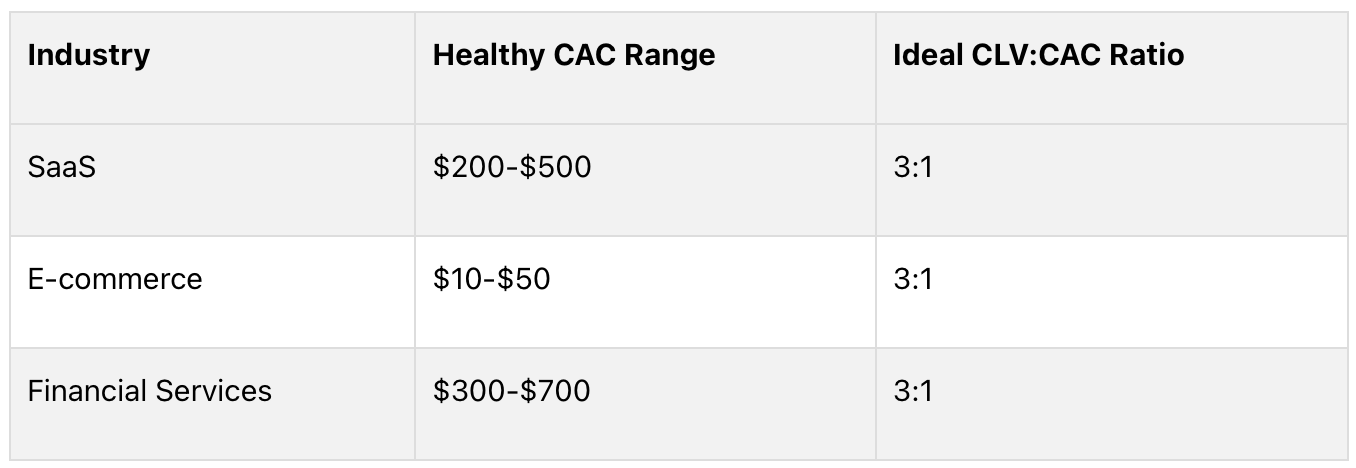
Lower CAC improves financial efficiency, freeing up resources to make your brand stand out.
Hidden Costs to Watch For
Don’t overlook hidden expenses like martech tools, sales team compensation, and content creation costs [2][4].
Tools to Improve CAC
Leverage tools like Google Analytics 4 for attribution tracking, CRM platforms to trace lead sources, and Rockerboxfor multi-touch tracking [1][3][4].
Industry Standards
Across industries, a healthy rule of thumb is that your customer's lifetime value (CLV) should be at least three times your CAC [2][4].
The Role of Privacy and AI
Privacy regulations are reshaping how we measure CAC. Consider "Influence CAC", which tracks how brand-building efforts lower acquisition costs over time [2][4]. This ties directly to the broader discussion of linking brand health to financial performance.
5. Customer Lifetime Value
Customer Lifetime Value (CLV) helps you understand the total revenue a customer can bring over their relationship with your business. While CAC (Customer Acquisition Cost) focuses on what it takes to acquire a customer, CLV highlights the long-term payoff of that investment.
How to Calculate CLV
To calculate CLV accurately, you’ll need three key metrics:
- Average purchase value
- Purchase frequency
- Customer lifespan
For example, if a customer spends $100 per transaction, makes four purchases a year, and stays with your business for five years, their CLV would be $2,000 [2][3].
Industry Averages
Here’s how CLV looks across different industries:
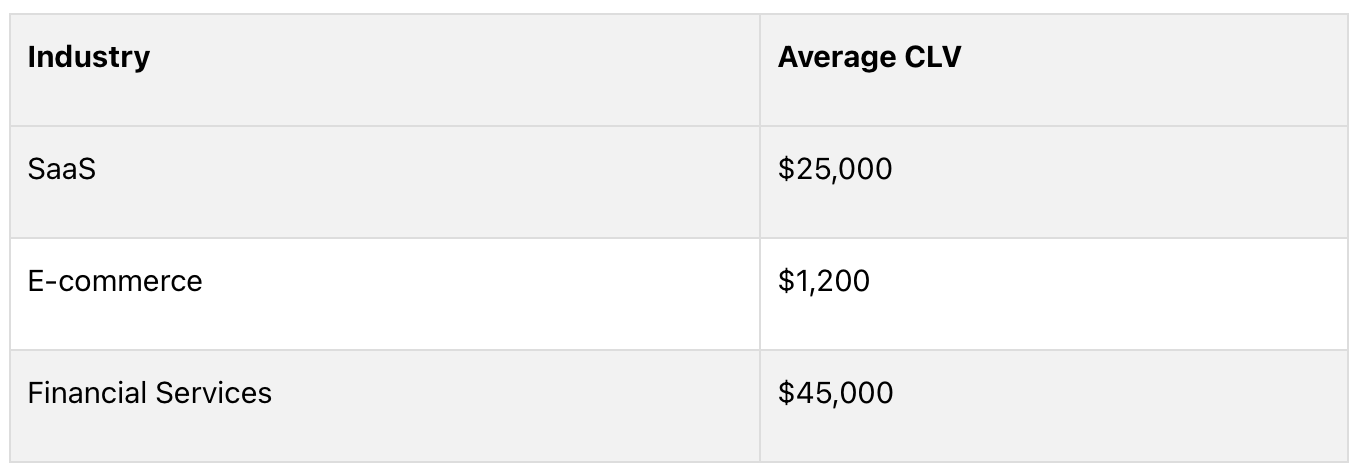
Tools for Better CLV Tracking
Modern tools like Salesforce Einstein Analytics take CLV tracking to the next level. By integrating social sentiment data, businesses like L'Oréal have improved their CLV predictions by 37% using AI-driven models [3][4][6].
Real-World Example: Starbucks Rewards
Starbucks uses its rewards program to boost CLV. Members visit six times a month on average, compared to just two visits for non-members. This app-based tracking significantly increases customer spending [3][5].
The Role of Data Quality
Poor data is a challenge for many - 42% of marketers struggle with incomplete customer journey insights [4][6]. Unified Customer Data Platforms (CDPs) can solve this by:
- Tracking customer interactions across channels
- Measuring purchase habits
- Analyzing overall customer behavior
Understanding CLV helps businesses focus on their most valuable customers, guiding strategies to build stronger, long-term relationships. It also ties directly to website conversion rates, showing how well you’re turning visitors into loyal buyers.
6. Website Conversion Rates
Website conversion rates show how well your digital presence turns visitors into customers or leads. While CLV (Customer Lifetime Value) focuses on long-term gains, conversion rates highlight immediate success in engaging your audience.
Industry Benchmarks
Different industries have varying conversion averages. Knowing these benchmarks helps set realistic goals:
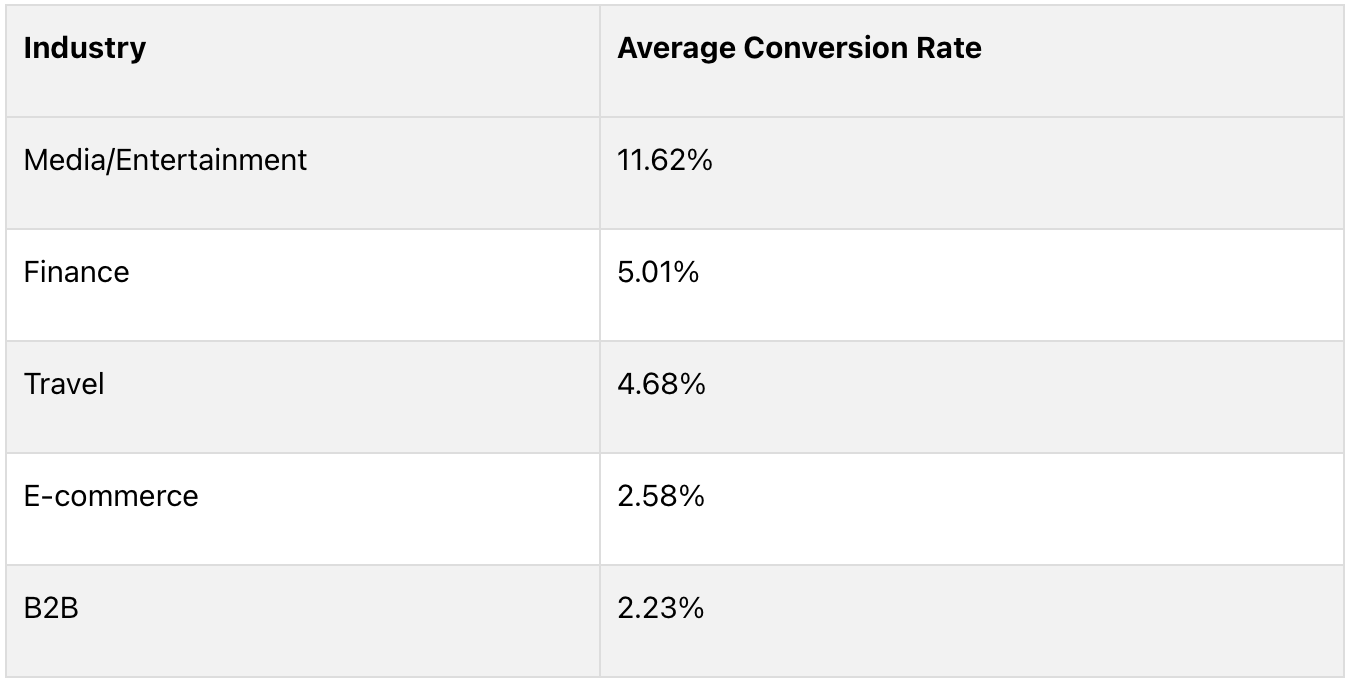
Mobile vs Desktop Performance
Mobile users convert 40% less often than desktop users [1]. This gap highlights challenges with mobile optimization and the risk of damaging brand trust. Slow-loading mobile sites, for instance, can make even premium brands seem unreliable.
Key Performance Indicators
Micro-conversions, like newsletter signups or account creations, reveal where users encounter obstacles in their journey. Tracking these smaller actions helps identify problem areas and improve the overall experience.
Speed's Impact on Conversions
Website speed plays a major role in both conversions and how users perceive your brand. Research shows that a 1-second delay in load time can cut conversions by 7%. Even worse, 79% of users will abandon a site if it takes longer than 3 seconds to load [3].
AI-Driven Improvements
AI tools are becoming a game-changer for conversions. For example, Walmart increased its conversion rate from 2.9% to 4.1% by using AI to provide personalized shopping recommendations that aligned with its “effortless shopping” promise [3].
Tools for Tracking
To effectively monitor and improve conversion rates, CMOs should rely on tools that provide actionable insights:

Content and Brand Alignment
Content that aligns with your brand identity plays a critical role in driving conversions. These insights also tie into social media strategies, showing how engagement on different platforms leads to actions on your website.
7. Social Media Performance
Analyzing social media performance helps you understand how well your brand messaging connects with your audience before they even visit your website.
Social media metrics highlight how your audience engages with your content on various platforms. For instance, Instagram boasts an average engagement rate of 1.16%, making it a top choice for visual content strategies [1][3].
Platform-Specific Benchmarks (2024 Engagement Averages [2][4])
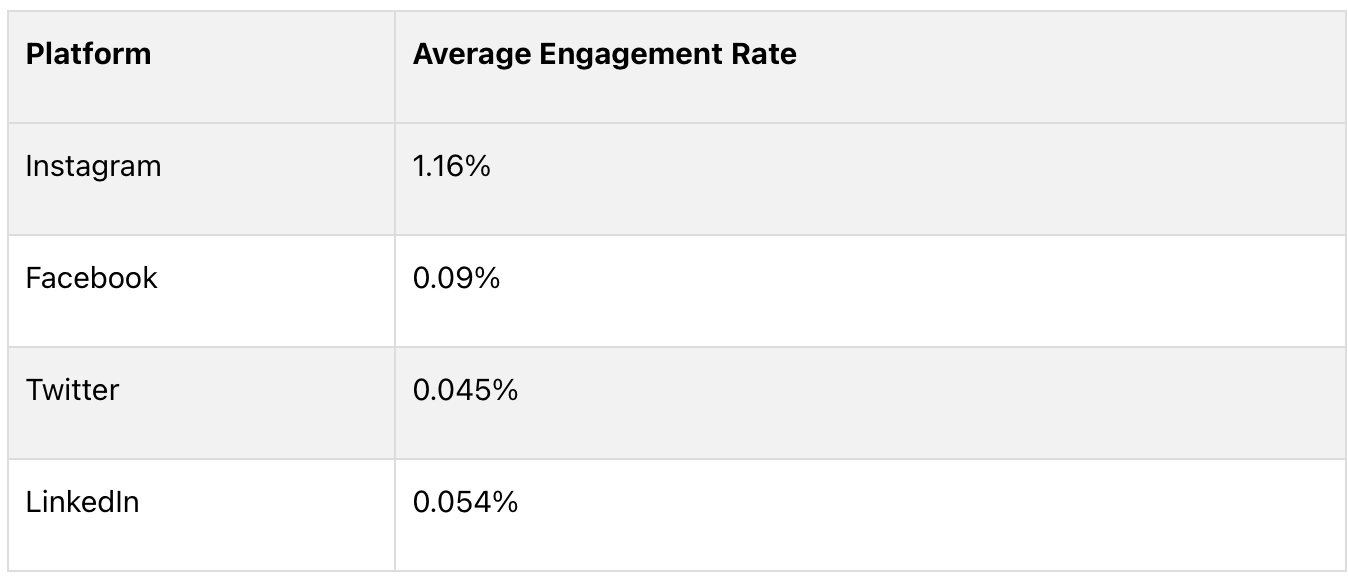
Key Metrics to Watch
- Quality Interactions: Focus on meaningful actions like thoughtful comments, shares, and saved posts. These signal that your content is connecting with your audience.
- Sentiment Analysis: Advanced tools now classify user sentiment (positive, neutral, or negative) with up to 89% accuracy [1]. This gives you a clearer understanding of how people perceive your brand.
Connecting Social Metrics to Conversions
Using UTM parameters in your campaign links allows you to track how social media engagement drives traffic and conversions on your website. This insight is essential for evaluating your return on investment (ROI).
Leveraging AI for Better Engagement
Tools like Semrush can identify trending topics in real time, helping you tweak your content strategy on the fly. For example, one retailer saw an 18% boost in engagement after adapting their content based on trending insights [1][5].
Practical Example: Sentiment Analysis in Action
A pizza chain noticed a 40% spike in negative mentions about the "soggy texture" of a new crust. After tweaking the recipe, positive sentiment rose by 22%, and Instagram story completion rates jumped by 15% within three weeks [1][5].
Tracking Content Performance
Short-lived content, like Instagram Stories, plays a big role in building brand awareness. Keeping tabs on these interactions helps you measure engagement and understand your brand's impact [1][3].
These insights are critical for calculating marketing ROI, especially when comparing the effectiveness of paid versus organic campaigns.
8. Marketing ROI Measurement
Understanding marketing ROI is essential for CMOs to justify spending and make informed decisions about channel investments. The basic formula is simple: [(Revenue Attributable to Marketing - Marketing Investment) / Marketing Investment] × 100. But today’s strategies demand a more detailed approach.
Three-Tiered Measurement Framework
A layered framework helps balance short-term results with long-term brand growth:
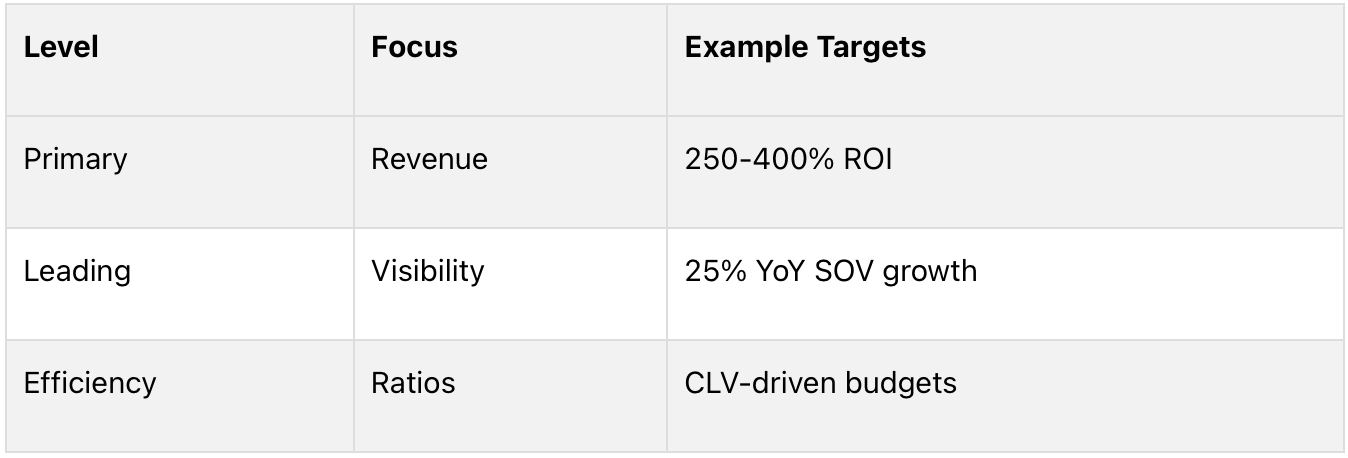
This structure connects campaign performance to overall brand equity.
Advanced Attribution Models
Multi-touch attribution is now a must-have for precise ROI tracking. For example, Adobe's marketing team merged CRM data with website analytics in 2022. This led to a 23% boost in ROI and allowed them to reallocate $5 million to more effective channels [1][2].
Industry-Specific ROI Benchmarks
Different industries see varying ROI benchmarks. Consumer goods typically achieve 250% ROI, with top performers exceeding 400%. Meanwhile, B2B SaaS averages around 180% [2].
AI-Powered ROI Prediction
AI is reshaping ROI analysis, offering prediction accuracy of up to 89% in leading marketing platforms [2]. Here's a real-world example:
"Our predictive modeling reduced CAC errors by 22% while forecasting creative impact on 30-day ROI" [2].
Brand Health's Influence on ROI
Brand health metrics are closely tied to financial performance [2]. This ties into CLV-focused strategies from Section 5, which emphasize retaining high-value customers. Additionally, the link between tracked NPS (Section 3) and repeat purchase ROI highlights the importance of integrated metrics. By analyzing ROI accurately, marketers can pinpoint which channels drive the most qualified leads.
9. Lead Conversion Success
Marketing ROI measures campaign effectiveness, but lead conversion success focuses on how efficiently interest is turned into revenue.
Key Metrics for Conversion Success
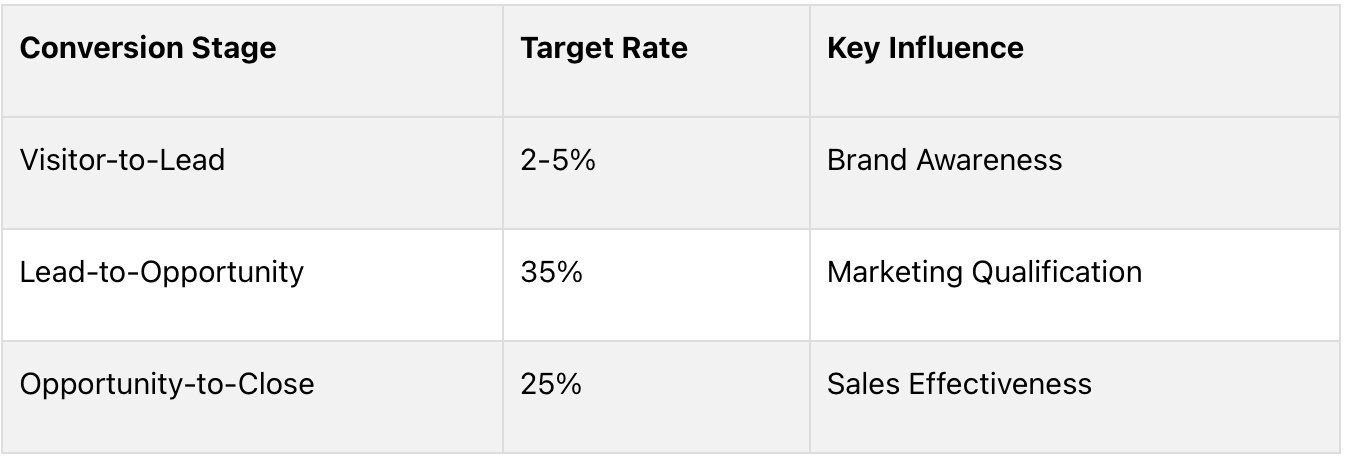
When enterprise B2B companies follow this framework, they can achieve an overall conversion efficiency of 8.75%, provided everything is executed correctly [2][4].
The Role of Advanced Lead Scoring
A strong lead scoring system evaluates three main factors: demographic fit (40%), engagement (30%), and intent signals (30%). Leads that score above 80 points are five times more likely to convert compared to ungraded leads [4].
Testing for Better Results
The format of your content matters. For example, video case studies have been shown to increase manufacturing lead conversions by 22% compared to text-only content [2]. This highlights how presentation can shape brand perception.
Calculating the True Cost of Conversion
Here’s the formula to determine cost-per-conversion:
(Total Marketing Spend + Sales Enablement Costs) ÷ Number of Converted Leads
For instance, if a company invests $500,000 and converts 200 leads, the cost per conversion comes out to $2,500 [2][4]. This metric is essential for evaluating how well brand messaging reduces sales barriers across different channels.
10. Brand Value Assessment
Lead conversion focuses on short-term results, but assessing brand value offers insights into its long-term impact. This process depends on three key factors:
Core Components
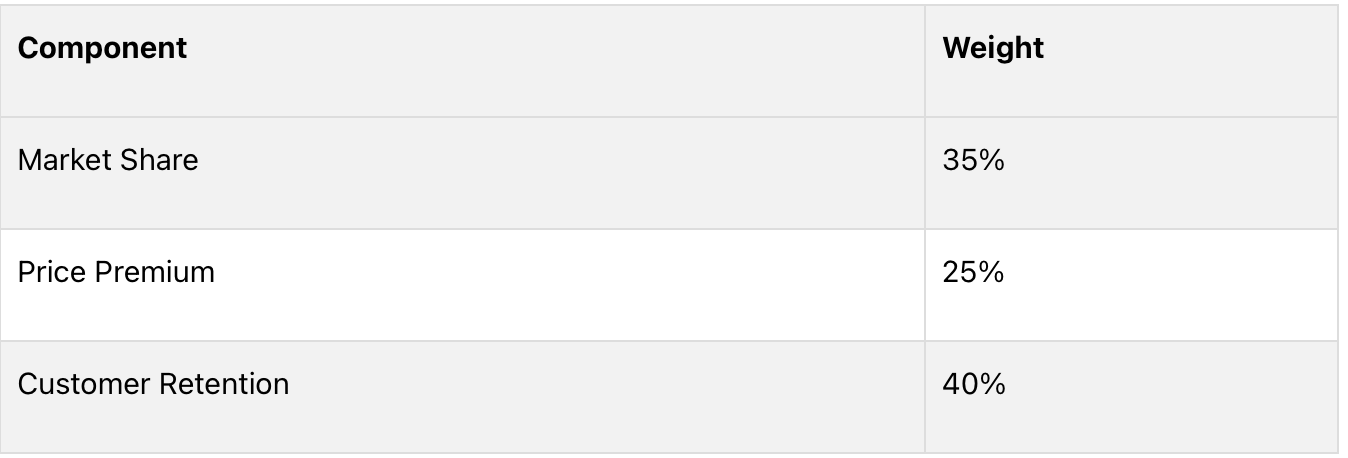
Customer Retention connects directly to the CLV metrics discussed in Section 5, offering a complete picture of brand performance.
Real-World Examples
Take Nike, for instance. Between 2023 and 2024, the company boosted its brand value by 45%. This growth stemmed from an 18% rise in search activity and a 22% acceptance rate for premium pricing [2][3]. Similarly, Adobe's integrated strategy (highlighted in Section 1) demonstrates how aligning efforts can enhance brand value.
Three-Phase Measurement Approach
To measure brand value effectively, organizations typically follow this structure:
- Digital Indicators: Monitored quarterly
- Financial Models: Evaluated annually
- Third-Party Audits: Conducted every two years [2][9]
Connecting Brand Value to Growth
Strong brands often lead to better financial outcomes. An analysis of the S&P 500 shows that companies in the top valuation quartile achieve 3.2 times higher market-adjusted returns over five years [2][6]. The correlation (r=0.79) between brand value growth and shareholder returns highlights the importance of this metric for CMOs.
Current Trends in Valuation
Brands aligned with ESG principles are now seeing valuation multiples that are 19% higher than their peers [2][6]. This demonstrates how ethical positioning can directly influence brand equity.
"Accurate assessment requires blending financial metrics with consumer sentiment data [9]"
To truly capture a brand's worth, companies must combine traditional financial data with consumer perception metrics and digital performance insights. This approach ensures a more comprehensive understanding of total brand equity.
Tools and Methods Comparison
Tracking metrics effectively means using tools that align with your brand's specific goals - from building awareness (Section 1) to evaluating value (Section 10). The right choice depends on your organization's size and measurement needs.
Enterprise vs. SMB Solutions
Enterprise tools, like SEMrush Media Monitoring, offer advanced features and handle large-scale data analysis, making them ideal for bigger organizations. On the other hand, tools designed for SMBs focus on affordability and essential features.
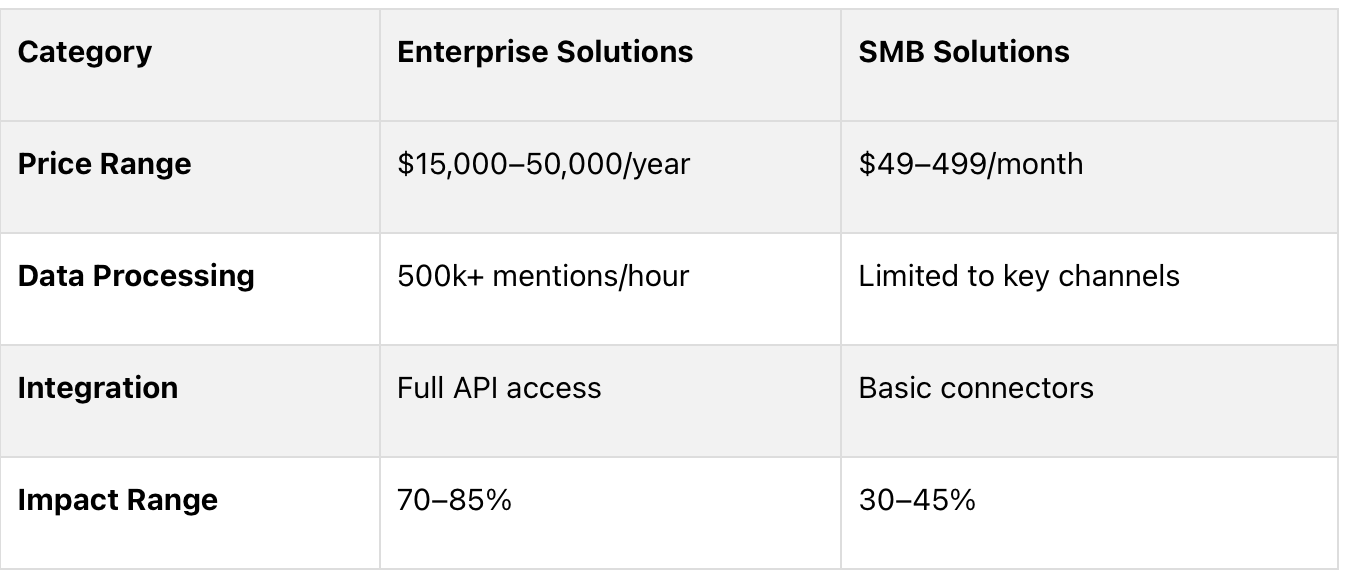
These tools play a key role in measuring metrics like Share of Voice (Section 2) and Marketing ROI (Section 8).
Combining Methods for Better Accuracy
Combining techniques can lead to better results. For example, pairing social listening with surveys improves accuracy by 42% [5]. Integrated dashboards also help keep metrics organized while avoiding overlap.
AI-Powered vs. Human Analysis
For tasks like NPS analysis (Section 3) and social listening (Section 7), a mix of AI and human input often works best. Here's how they compare:
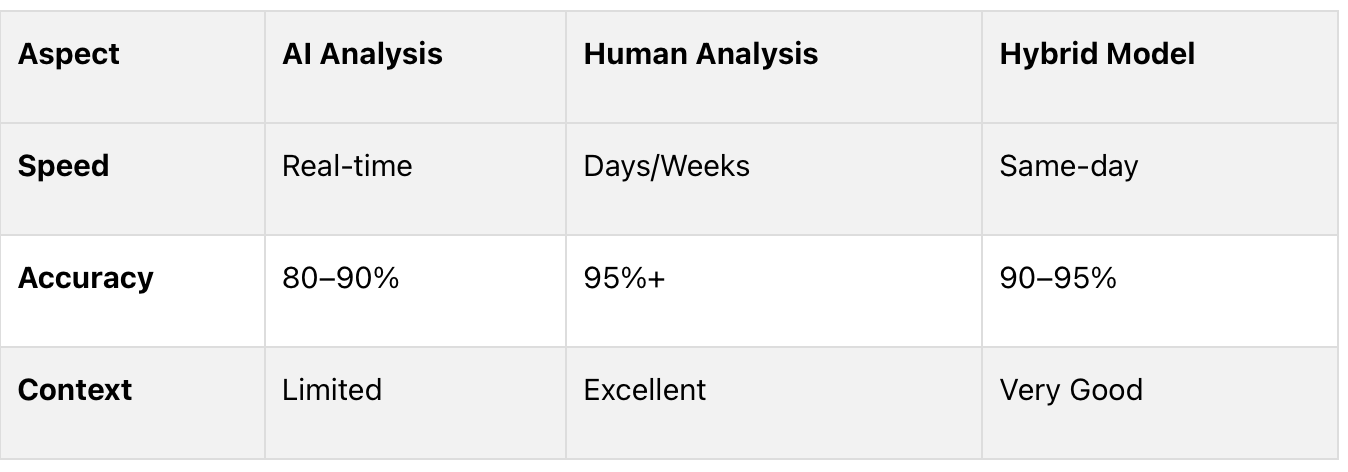
Integration Capabilities
Top platforms like Sprout Social and Brandwatch excel at pulling data from multiple sources. Medallia stands out by linking NPS scores with customer sentiment from support interactions [6], giving CMOs a complete picture of brand health.
Balancing Costs and Benefits
Premium tools require a higher investment but often deliver clear, measurable results.
Focus on Real-Time Monitoring
Modern platforms increasingly highlight real-time tracking, allowing brands to stay ahead in fast-changing environments.
Key Takeaways
Building an effective brand strategy means focusing on the 10 core metrics and prioritizing them based on your business stage. According to Forrester, companies that track six or more metrics see 2.3x faster revenue growth than their competitors.
Strategic Implementation by Business Phase
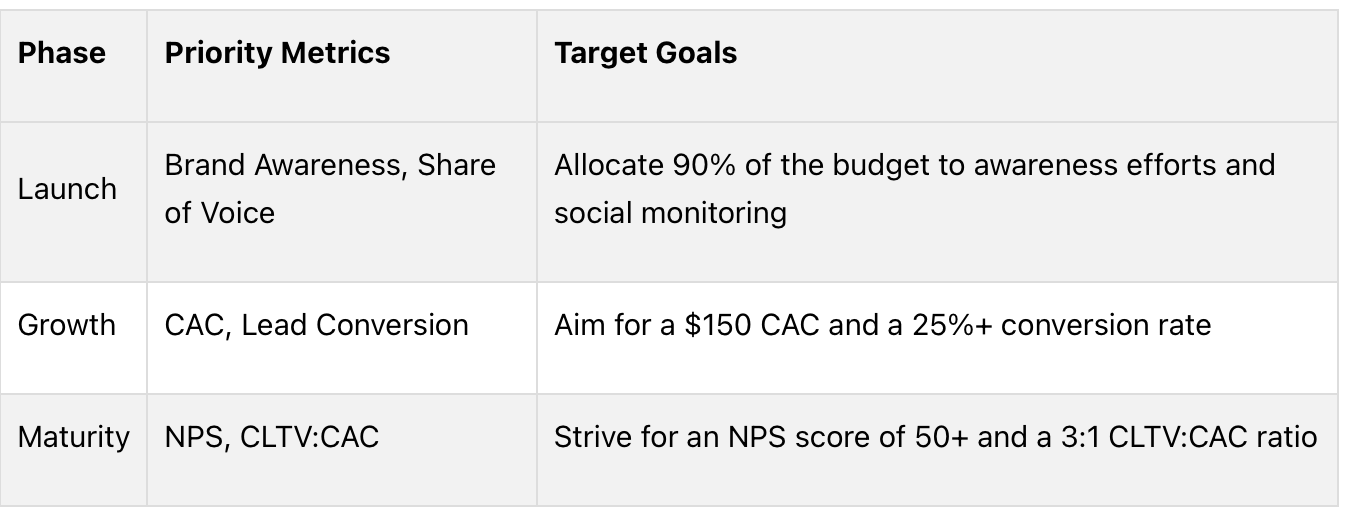
These priorities are rooted in the interconnected metrics framework discussed in earlier sections.
Data-Driven Success Factors
A balanced approach works best: 70% quantitative metrics (like CLTV and conversions) combined with 30% qualitative insights (such as social sentiment and surveys) [2][3].
Technology Integration Impact
AI-powered tools are changing how metrics are tracked. Current platforms can:
- Predict NPS trends by analyzing sentiment patterns
- Automate share-of-voice tracking in over 50 languages
- Use machine learning to forecast CLTV [4][6]
Cross-Functional Communication
Translate metrics into business-focused outcomes. For example:
- Brand awareness can be reframed as "Market Footprint Potential"
- ROI can be presented as "Revenue Per Dollar Invested" [4][6]
Future-Proofing Your Metrics
Automation is shaping the future of brand measurement. Expect advancements in cross-channel sentiment analysis and real-time market share tracking. Nike's recent valuation growth, discussed in Section 10, highlights the importance of these tools [1][3].
Risk Mitigation
Focus on:
The secret to success is choosing metrics that match your business's growth stage while staying flexible enough to adapt to changing market conditions.


